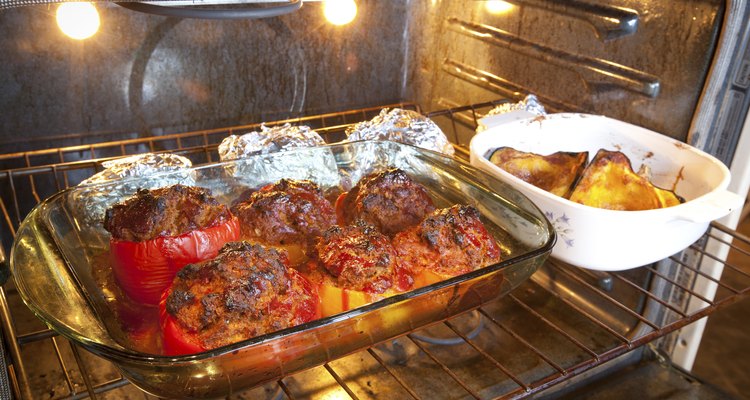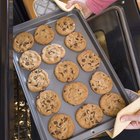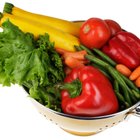
jdwfoto/iStock/Getty Images
Convection ovens represent something of an upgrade on the conventional oven, thanks to their ability to guide air around the oven cavity with a fan. Faster and more efficient, so-called forced-air ovens make light work of roasts and vegetables. Be aware, however, that in some cases the conventional oven remains the better option.
Basic Features
The convection oven first appeared in commercial kitchens in the 1950s but still has the power to baffle cooks in the domestic environment. A convection oven can be a standalone countertop unit or part of an integrated range. A conventional oven, sometimes referred to as a thermal oven, merely surrounds food with hot air radiating from top and bottom elements. Convection ovens circulate the air with a fan, usually from the back of the oven. As a result, food cooks more quickly and evenly because hot spots cannot build up, and the internal temperature remains steady. In addition, conventional ovens can brown food unevenly, usually requiring the cook to turn dishes during cooking, while convection ovens give a uniform finish.
Cooking Advantages
Because moving air transfers heat more quickly than still air, convection ovens reduce cooking times and save energy. When you're working from a recipe based on a conventional oven, reduce the cooking time by a quarter and set the oven about 25 degrees Fahrenheit lower than stated. Convection roasting brings out the best in certain dishes, yielding deliciously crisp skin on poultry, and flaky pastry and crusts on pies and croissants. Vegetables caramelize quickly, giving crisp edges while the inside remains moist. For baked goods, expect lighter, taller and flakier pastries as the steam released by the butter expands more than in a thermal oven. Convection ovens also help you cook many dishes simultaneously -- such as a holiday spread of roast bird and vegetables, or trays of cookies -- because the racks cook at a uniform temperature wherever they are placed.
Oven Workings
The most efficient convection ovens have a third heating element behind the fan, not just on the top and bottom of the oven. In these ovens, often referred to as "true or European convection" ovens, the fan blows already hot air into the oven cavity. Less-efficient models place the fan outside of the oven and blow cooler air into the hot air. This results in an uneven temperature. Bear in mind that few true convection ovens are gas-powered, because an electric element is the heating vehicle of choice.
Baking Bad
Not all foods are ideal for the dry, hot currents of the convection oven. Baked goods such as souffles, for example, benefit from the humid air of a conventional oven. Some cookies and breads dry out too quickly before the inside is finished. For the best results, ensure that air is allowed to circulate. Avoid covering oven racks or dishes with aluminum foil, which blocks circulation. Use pans with low sides to facilitate air flow when baking cookies, or roasting meats or trays of vegetables, for example. For high-sided or covered dishes such as Dutch ovens, however, the convection oven has no clear advantage and you may want to turn off the fan.
Related Articles

Baking Vs. Roasting in Convection Ovens

What Are the Benefits of Cooking With a ...

What Causes Uneven Baking in Cookies?

How to Cook Cakes and Biscuits in a ...
Convection Broiling Vs. Convection ...
How to Cook in Tabletop Convection Ovens

Does a Roaster Oven Cook Faster Than ...

Difference Between Baking on the Top & ...

Do I Cover or Uncover When Baking?

Cooking With a Countertop Halogen Lamp

Advantages & Disadvantages of Dry ...
How to Cook in a Gas Stove or Oven

Roasting Vegetables in a Convection Oven

How to Clean an Oven Liner

Can You Cook Dessert & Dinner in the ...

What Is a Baking Wire Rack?

Different Types of Food in India

What Is the Best Cookware for Electric ...

Does Baking Dough Kill Bacteria?
Difference Between Cooking in a Regular ...
References
Resources
Writer Bio
Nick Marshall is a UK-based writer specializing in trends and best-practice in the B2B sector.
Photo Credits
jdwfoto/iStock/Getty Images